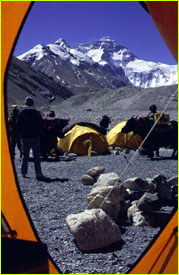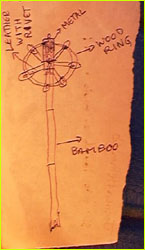
|
 |
 |
by Liesl Clark April 28, 1999 It all begins with the zipper noise. Before the sun's rays can be felt, someone in a tent nearby will rustle around groping for the door zipper of their tent and then, as predictable as the warmth that comes from the sun's first rays, that unmelodious zipper noise wakes you up, like a short loud buzz from a mosquito. Days begin and end here with the zipper noise. It's "good morning" and "good night" wrapped up in one high-pitched, short-lived plastic whine, a good reminder that, yes, we're still here on Everest. Today is another day of waiting for winds to calm and for our eight climbing Sherpas to carry more oxygen up to Camp V for the search attempt. The Sherpas, led by Sirdar (Sherpa leader) Dawa Nuru, left Advance Base Camp at 6:00 A.M. "We're waiting out the wind," explained Dave Hahn, who called down to us at Base Camp on the radio. "Can you send up more reading material?" asked climber Tap Richards. The team members will all make carries up to the North Col, as more oxygen and supplies are still needed up high. They will then return to Advance Base Camp to sleep, and the decision will be made tonight whether they will continue up higher tomorrow and begin the search sequence. Although we're in waiting mode, life here continues to turn up interesting news. Brazilian climbers Paulo and Helena Coelho came by this morning to show our historian, Jochen Hemmleb, a drawing of a relic they found last year during their attempt on the North Face of Everest. This route, different from the traditional North Col route, took them up the Central Rongbuk Glacier to their Advance Base Camp. "We were walking to the Base Camp of the North Face and we saw it down the way, just off the trail," said Helena Coelho while gesturing to a map of their route. The Coelhos are back on Everest again making an attempt on the North Col route.
As our tents flap relentlessly in the wind and Everest's characteristic plume cloud streams across the Himalayan sky, we remind ourselves that the wind must have thwarted Everest's early mountaineers, too. From our predecessors, we now know that May is traditionally the best month to climb Everest, in the few weeks before the monsoon snows arrive, when the jet stream winds move off Everest's upper slopes. It was in the 1930s that the British began re-thinking their Everest timetable. The 1935 reconnaissance brought a British team to Tibet during the months of July and August to collect data about the monsoon. Needless to say, the expedition did not get very high that year, due to heavy snowfall. The year, according to Everest historian Walt Unsworth, went down in history as a good lesson learned: "Snow conditions above 23,000 feet were always abominable. From this it was concluded that the monsoon period was unsuitable for high-altitude climbing." For us, it will only be a matter of a few weeks before the snows of the monsoon beset the upper mountain. Ominous clouds roll in and cover the high slopes of Everest as the sun fades. A pink alpenglow dominates the upper third of the mountain. At our 6:00 P.M. radio call, Richards reports from Advance Base Camp: "We all made a carry to the North Col today. The Sherpas made a carry to Camp V. We'll move up to the Col and sleep there tomorrow, and the Sherpas will make a carry again to Camp V." Check back tomorrow as the team moves up to sleep at the North Col. They will try to move up to Camp V the following day for their search attempt. Unanswered Questions (May 25, 1999) Forty-Eight Yaks (May 21, 1999) On Top of the World (May 17, 1999) Summit Team Moves Higher (May 16, 1999) Still at Camp V (May 15, 1999) Snow Bound (May 14, 1999) Outsmarting the Weather (May 13, 1999) Last Trip Up (May 12, 1999) Up to ABC/The Rescue (May 11, 1999) The Image of Mallory (May 8, 1999) In Extremis (May 7, 1999) Pieces of the Puzzle (May 6, 1999) Dearest George (May 5, 1999) Mallory's Discoverers Return (May 4, 1999) Mallory Reported Found (May 3, 1999) Waiting in Silence (May 1, 1999) Up to the Search Site (April 30, 1999) To the North Col (April 29, 1999) Waiting out the Wind (April 28, 1999) Search About to Begin (April 25, 1999) Pitching a 1933 Tent (April 23, 1999) Early Camp Found at 21,750 Feet on Everest (April 20, 1999) Up to Base Camp (April 23, 1999) Photos: (1) Thom Pollard; (2) Liesl Clark. Lost on Everest | High Exposure | Climb | History & Culture | Earth, Wind, & Ice E-mail | Previous Expeditions | Resources | Site Map | Everest Home Editor's Picks | Previous Sites | Join Us/E-mail | TV/Web Schedule About NOVA | Teachers | Site Map | Shop | Jobs | Search | To print PBS Online | NOVA Online | WGBH © | Updated November 2000 |
 Base Camp, North side of Mount Everest
Base Camp, North side of Mount Everest
 Paulo and Helena Coelho's sketch of the old-style
bamboo ski pole they found last year.
Paulo and Helena Coelho's sketch of the old-style
bamboo ski pole they found last year.